From inside (document excerpt):
24ABS Baset Series Air Conditioners 1 1/2 To 5 Nominal Tons (Sizes 18 to 60) Installation Instructions SAFETY CONSIDERATIONS Improper installation, adjustment, alteration, service, maintenance, or use can cause explosion, fire, electrical shock, or other conditions which may cause death, personal injury, or property damage. Consult a qualified installer, service agency, or your distributor or branch for information or assistance.
Heating, Ventilating and Air Conditioning User Manual Free Download. HAVC Operator’s Manual. Auto AC Free Instruction Manual Download PDF.
The qualified installer or agency must use factory-authorized kits or accessories when modifying this product. Refer to the individual instructions packaged with the kits or accessories when installing. Follow all safety codes. Wear safety glasses, protective clothing, and work gloves. Use quenching cloth for brazing operations. Have fire extinguisher available. Read these instructions thoroughly and follow all warnings or cautions included in literature and attached to the unit. Consult local building codes and National Electrical Code (NEC) for special requirements. Recognize safety information. This is the safety-alert symbol When you see this symbol on the unit and in instructions or manuals, be alert to the potential for personal injury. Understand these signal words; DANGER, WARNING, and CAUTION. These words are used with the safety-alert symbol. DANGER identifies the most serious hazards which will result in severe personal injury or death. WARNING signifies hazards which could result in personal injury or death. CAUTION is used to identify unsafe practices which would result in minor personal injury or product and property damage. NOTE is used to highlight suggestions which will result in enhanced installation, reliability, or operation. 6. Avoid direct tubing contact with water pipes, duct work, floor joists, wall studs, floors, and walls. 7. Do not suspend refrigerant tubing from joists and studs with a rigid wire or strap which comes in direct contact with tubing.(See Fig. 1.) 8. Ensure that tubing insulation is pliable and completely surrounds vapor tube. 9. When necessary, use hanger straps which are 1 in. (25.4 mm) wide and conform to shape of tubing insulation. (See Fig. 1.) 10. Isolate hanger straps from insulation by using metal sleeves bent to conform to shape of insulation. NOTE: Avoid contact between tubing and structure OUTDOOR WALL INDOOR WALL CAULK LIQUID TUBE INSULATION THROUGH THE WALL HANGER STRAP (AROUND VAPOR TUBE ONLY) VAPOR TUBE JOIST INSULATION VAPOR TUBE ! WARNING 1 ” (25.4 mm) MIN. SUSPENSION LIQUID TUBE ELECTRICAL SHOCK HAZARD Failure to follow this warning could result in personal injury or death. Before installing, modifying, or servicing system, main electrical disconnect switch must be in the OFF position. There may be more than 1 disconnect switch. Lock out and tag switch with a suitable warning label. A94026 Fig. 1 – Piping Installation The outdoor unit contains system refrigerant charge for operation with ARI rated indoor unit when connected by 15 ft. (4.57 m) of field-supplied or factory accessory tubing. For proper unit operation, check refrigerant charge using charging information located on control box cover and/or in the Check Charge section of this instruction. IMPORTANT: Maximum liquid-line size is 3/8-in. OD for all residential applications including long line. IMPORTANT: Always install the factory-supplied liquid-line filter drier. If replacing the filter drier, refer to Product Data Digest for appropriate part number. Obtain replacement filter driers from your distributor or branch. INSTALLATION INSTRUCTIONS NOTE: In some cases noise in the living area has been traced to gas pulsations from improper installation of equipment. 1. Locate unit away from windows, patios, decks, etc. where unit operation sound may disturb customer. 2. Ensure that vapor and liquid tube diameters are appropriate for unit capacity. 3. Run refrigerant tubes as directly as possible by avoiding unnecessary turns and bends. 4. Leave some slack between structure and unit to absorb ….. …


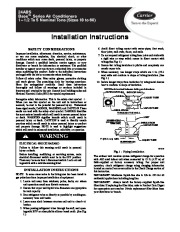 Carrier Owners Manual - 1 of 6
Carrier Owners Manual - 1 of 6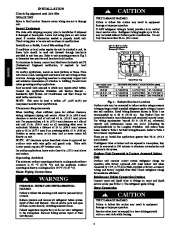 Carrier Owners Manual - 2 of 6
Carrier Owners Manual - 2 of 6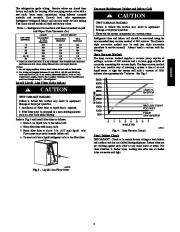 Carrier Owners Manual - 3 of 6
Carrier Owners Manual - 3 of 6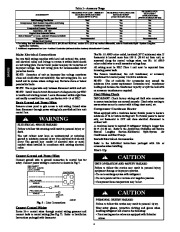 Carrier Owners Manual - 4 of 6
Carrier Owners Manual - 4 of 6 Carrier Owners Manual - 5 of 6
Carrier Owners Manual - 5 of 6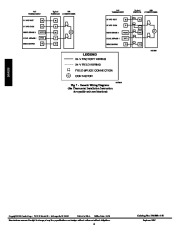 Carrier Owners Manual - 6 of 6
Carrier Owners Manual - 6 of 6